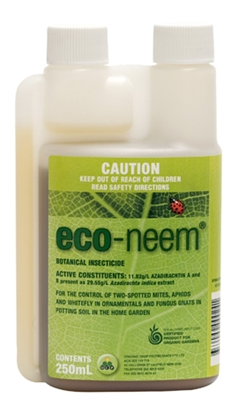 Eco-neem® is making its presence felt across the industry as a safe organic insecticide. Steve Falcioni, from Organic Crop Protectants (OCP), tells us more.
Eco-neem® is making its presence felt across the industry as a safe organic insecticide. Steve Falcioni, from Organic Crop Protectants (OCP), tells us more.
We’re very pleased to announce that the APVMA has recently expanded the registration of eco-neem® for the following insects:
This is in addition to the existing registration of:
Eco-neem® is a very broad spectrum organic insecticide and the label is now finally starting to reflect that. Overseas registration exists for grasshoppers, snails, thrip and many other insects. In time we will hopefully see these insects come on label locally.
So what is eco-neem®?
We refer to it as nature’s insecticide as it is 100% derived from plants with no nasty tinkering in a chemical lab. In fact it’s certified organic by the Biological Farmers of Australia (BFA). It is a blend of plant oils combined with Azadirachtin A & B (the active compounds). Azadirachtin A & B are extracts from the seed kernel of the neem tree (Azadirachta indica).
The neem tree is native to India and nearby regions. Freshly extracted neem oil has been used for hundreds of years by people in these regions as a natural and safe insecticide. Unfortunately straight neem oil is not a very stable substance and the active azadirachtin breaks down pretty quickly (within 3-6 months).
Eco-neem® overcomes this problem by having the azadirachtin removed from the neem oil, concentrated and mixed with other plant oils. This ensures eco-neem® is a stable product that has a two year shelf-life.
How does it work?
Eco-neem® has multiple modes of action including:
This unique multi-faceted mode of attack is what makes eco-neem® such an effective insecticide. The ability for insects to develop resistance is incredibly small.
eco-neem® can be sprayed over foliage or drenched through the soil. When pest insects ingest the product the azadirachtin starts attacking in the methods described above. It is important to note that insect death is not instant. Insects will stop damaging plants as soon as they have taken their first bite of eco-neem but can take several days to actually die.
eco-neem® has some trans-laminar activity meaning it will soak into the first few layers of plant tissue providing residual protection for up to 14 days after spraying. It is not however a true systemic spray so good coverage is still required when spraying.
What about the ladybeetles and bees?
eco-neem® is only harmful if ingested by an insect. So pests that suck and chew on plants are killed while beneficials like ladybeetles, lacewings and hoverflies are not harmed. Research has also shown that insects and animals that feed on insects killed by eco-neem® are not harmed either. The azadirachtin is quickly metabolized in the first insect’s body and has no residual potency for the secondary predator.
eco-neem® has also been shown to be safe to bees and to not impact on larger creatures like lizards and birds.
Can it be sprayed on edible plants?
Current registration in Australia for eco-neem® is for use on ornamentals only. Further work is being done and it is hoped that the APVMA will allow its use for edible plants in the near future. This product is already registered in New Zealand, the USA and many parts of Europe for use on edibles with no withholding period.